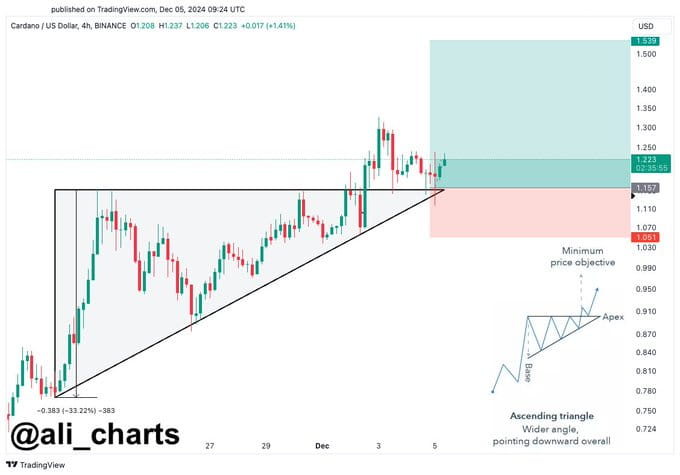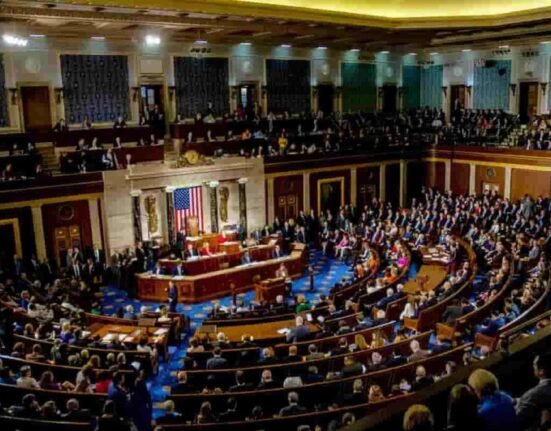Decentralized finance (DeFi) cryptocurrency Cardano (ADA) has recorded an uptick in whale activity, a shift that remains key to helping the asset sustain its price above $1.
The whales accumulated over 100 million ADA in the past 24 hours, coinciding with a period when the token attempted to stabilize around the $1.22 spot, according to data shared by cryptocurrency on-chain analyst Ali Martinez in an X post on December 5.

Specifically, the purchase involved wallets holding between 1 million and 10 million ADA. Historically, when these high-net-worth wallets accumulate an asset in large quantities, it has always acted as a precursor to further price growth.
ADA’s path to $1.5 resistance
Indeed, if the capital inflow is sustained, ADA will likely target the $1.50 resistance level, validating its recent price breakout after months of consolidation below $1.
Regarding price movement, Martinez had observed in an earlier post that ADA is forming a classic ascending triangle pattern.
Notably, this pattern is a bullish continuation signal, suggesting prices will likely break upward and continue a prior uptrend. The analysis noted that if ADA breaks the $1.23 resistance, the movement could open a path to $1.50.

However, Martinez has previously issued warnings about a potential ADA crash. According to a Coindatacap report on December 2, the prominent analyst suggested that the digital currency could experience a sharp drop to $0.88, as the chart had formed a rising wedge pattern—a bearish reversal indicator.
Overall, ADA’s price movements are tied to general market sentiment, which has turned bullish following speculation about Donald Trump’s re-election and the nomination of Paul Atkins as the next Securities and Exchange Commission chair.
Meanwhile, several on-chain developments aimed at increasing Cardano’s use cases support this momentum. For instance, on December 4, Cardano’s layer-2 scaling solution, Hydra, recorded 2 billion transactions in just 4 hours, surpassing the daily transaction volume of global payment giants like Visa.
ADA price analysis
In terms of price movement, ADA is showing short-term volatility. As of press time, it was trading at $1.20, with modest gains of less than 0.1%; on the weekly chart, it is up 21%.
ADA’s market sentiment is positive, bolstered by the Fear & Greed Index reading of 84, which indicates ‘Extreme Greed.’
From a technical standpoint, ADA is trading well above its 50-day and 200-day simple moving averages (SMA) at $0.6149 and $0.4626, respectively, signaling a possible continuation of bullish momentum.
However, the 14-day Relative Strength Index (RSI) is at 78.52, suggesting the asset is overbought and may be approaching a potential correction.
In conclusion, ADA is dominated by bullish sentiment, but the RSI reading and the extreme greed signal caution, as these momentum indicators point to a possible brewing correction.
Cardano is a blockchain and ADA is the coin that powers the Cardano network. This is similar in some ways to ether and the Ethereum blockchain.
Think of Bitcoin as Crypto 1.0. It’s essentially digital gold, but the system is beset with scalability issues. Then there’s Ethereum, often referred to as Crypto 2.0.
Cardano, launched in 2017, is Crypto 3.0, with the goal of improving upon the functionality that Ethereum was initially missing.
Charles Hoskinson founded Cardano, and he’s also a co-founder of Ethereum. Hoskinson had a falling out with the Ethereum team due to a dispute with co-founder Vitalik Buterin in 2014 regarding whether the Ethereum project should be commercial or not.
Hoskinson moved on to launch Cardano as a more scalable, interoperable and sustainable blockchain, intending to improve upon Bitcoin and Ethereum.
“Referred to by supporters as an ‘Ethereum killer,’ Cardano’s ongoing development is supported by the Cardano Foundation and the IOHK research institute, which engage in [resources and development] and peer review via a formal development model,” said Henrik Gebbing, co-CEO and co-founder of Finoa, a digital asset custodian.
One of the major criticisms of Bitcoin and other popular cryptocurrencies is that their blockchain networks, based on proof of work consensus mechanisms, waste huge amounts of energy. Cardano uses a proof of stake consensus mechanism, offering a more sustainable and scalable blockchain.
What Is ADA?
ADA is the cryptocurrency for the Cardano platform. Cardano’s coin is named after Ada Lovelace, a 19th-century mathematician known as the first computer programmer.
People use ADA tokens to pay transaction fees for using the platform. ADA’s also given out to the validators as a reward for running the proof of stake system.
How Does Cardano Work?
With a blockchain network, there needs to be a way to verify transactions to ensure people don’t spend the same tokens twice. Given the decentralization, there’s no central authority like a bank working to handle the job.
Based on proof of work consensus mechanisms, Bitcoin and Ethereum 1.0 miners run computers to solve complex mathematical equations and add new blocks of data to the blockchain, receiving crypto in exchange for their work. This is time-consuming and uses up large amounts of electricity.
Cardano uses staking, a process where network participants deposit set amounts of crypto to earn the right to participate in the operation of the blockchain.
“The [Cardano] protocol is designed to keep energy expenditure during the block production process to a minimum,” said Daniel Hill, president of Hill Wealth Strategies.
History of Cardano (ADA)
Charles Hoskinson, an Ethereum co-founder who left the project due to disagreements with the direction of Ethereum, began developing Cardano in 2015 and launched the blockchain network with the first mined block in 2017.2
Cardano considers itself an updated version of and has positioned itself as an alternative to Ethereum, anointing itself a “third-generation” platform compared with Ethereum’s “second-generation” credentials. Cardano has a self-proclaimed goal of providing banking services to the world’s unbanked.
An eponymous non-profit foundation, the Cardano Foundation, was established in 2017 to oversee the development of the Cardano blockchain and to promote its adoption. Prior to that, IOHK, an engineering company, was the primary developer of the Cardano blockchain. Throughout its history, the Cardano blockchain has undergone four notable hard forks in its history: the Shelley, Alonzo, Vasil, and Valentine hard forks.

The Shelley hard fork transitioned Cardano from a federated Byzantine Fault Tolerance (fBFT) consensus mechanism to a more decentralized PoS consensus mechanism called Ouroboros. The Alonzo hard fork enabled smart contracts on the Cardano blockchain for the first time, opening up the possibility for a wide range of dApps to be built on Cardano. The Vasil hard fork brought scalability upgrades to further improve dApp functionality, such as increased block size, improved transaction processing, and new scripting capabilities.
In February 2023, the Valentine upgrade occurred, causing another (planned) hard fork. The purpose of this update was to allow more efficient cross-chain applications to be built and add support for other protocols.
Who is the founder of Cardano?
De oprichters van Cardano ADA, Charles Hoskinson en Jeremy Wood, zijn twee van de meest invloedrijke figuren in de cryptocurrency-industrie. Hun visie voor een nieuwe generatie van cryptocurrency was baanbrekend. Hun platform wil revolutie teweegbrengen in de manier waarop mensen omgaan met digitale activa. Met hun expertise en toewijding aan innovatie helpen Hoskinson en Wood de toekomst van blockchaintechnologie vorm te geven.
What are Cardano native tokens?
On March 1, 2021, the Cardano blockchain introduced the ability to create native tokens. Like Ethereum tokens — which can include things like NFTs or stablecoins like USD Coin — Cardano native assets can be created and distributed on the blockchain and are able to interact with smart contracts.
But unlike Ethereum-based tokens, native tokens aren’t created via smart contract. Instead, they run on the same architecture as the ADA cryptocurrency itself. According to the nonprofit Foundation, this makes native assets “first-class citizens” on the blockchain. Their native architecture can theoretically make these tokens more secure and reduce the fees associated with transactions.
Disclaimer ||
The Information provided on this website article does not constitute investment advice,financial advice,trading advice,or any other sort of advice and you should not treat any of the website’s content as such.
Always do your own research! DYOR NFA
Coin Data Cap does not recommend that any cryptocurrency should be bought, sold or held by you, Do Conduct your own due diligence and consult your financial adviser before making any investment decisions!



